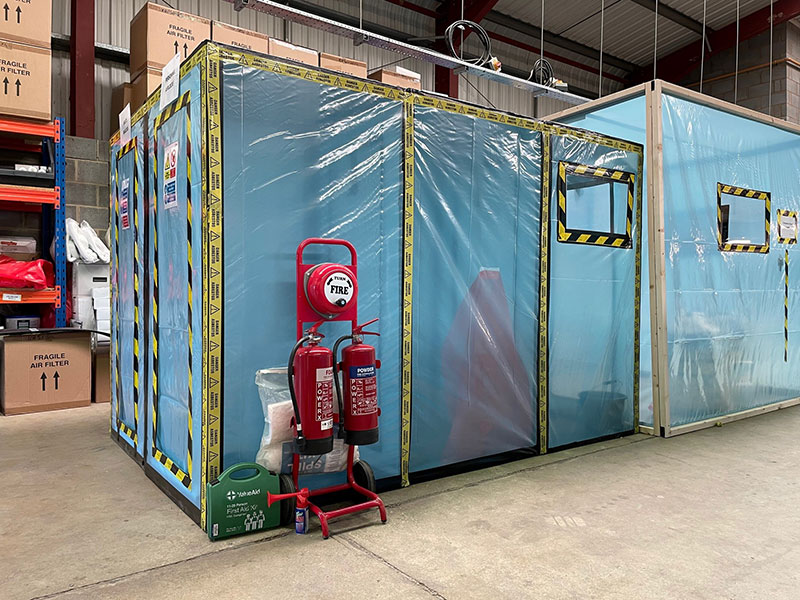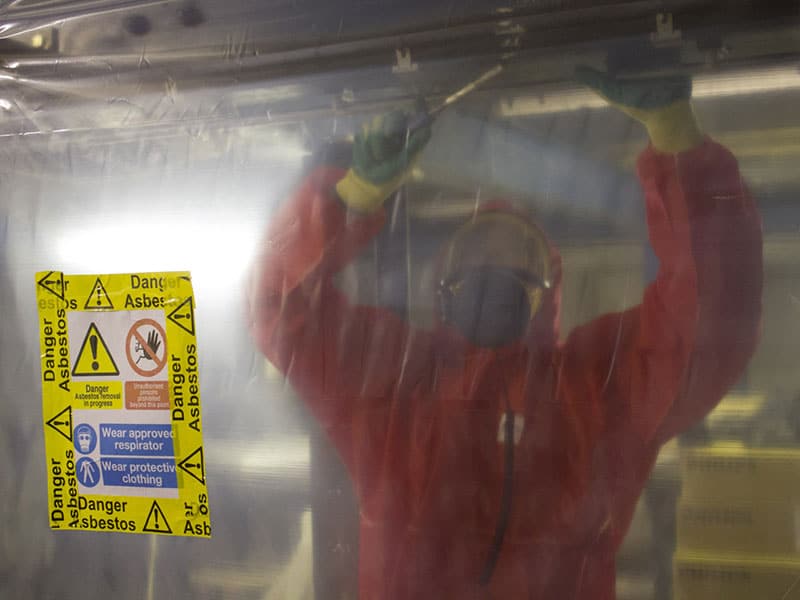What is the role of negative pressure and air extraction in licensed asbestos removal?
The term “negative pressure”, in this context, refers to air pressure that is slightly below atmospheric pressure. This is maintained inside an asbestos removal enclosure by the application of mechanical extract ventilation, with the aim being to ensure that any asbestos fibres released during the work are filtered out of the air, but kept within the enclosure.
This, in turn, helps to prevent any loose asbestos fibres from spreading beyond the enclosure, which could lead to it posing a serious risk to on-site workers, the wider public, and the environment. But what else do you need to know about how air extraction and negative pressure work in a situation where licensed asbestos removal work is being carried out?

What is negative pressure in asbestos removal?
The maintenance of negative pressure – in other words, air pressure that is slightly below atmospheric pressure – inside an asbestos enclosure, ensures that any leaks in the enclosure will be inwards, instead of outwards. This means that any loose asbestos dust will be kept inside the enclosure, instead of spreading beyond it.
The extraction of air from an asbestos enclosure means there will be a need for it to be replaced with an adequate amount of make-up air. This is usually achieved by allowing air to enter the enclosure in a controlled manner through the airlocks. As a consequence of this, ventilation of the enclosure will be regulated, and asbestos workers will receive a supply of clean air.
Why is negative pressure critical in asbestos removal work?
In a location where licensed asbestos removal work is undertaken, the principal method of preventing or reducing the spread of asbestos fibres is the erection of an enclosure under negative pressure around the work area.
However, even when the very best construction methods and materials are used in the installation of an enclosure, it will not be possible to achieve an absolutely airtight seal; at least some degree of leakage will always occur.
This helps to explain why air extraction systems are used to achieve – and maintain – negative pressure in an asbestos enclosure. The maintenance of negative pressure means that in the event of the enclosure being punctured, air would be sucked into the enclosure, as opposed to escaping out.
After all, if asbestos fibres are allowed to escape out of an enclosure, they could be easily swallowed or breathed in by someone nearby. This could lead to the exposed individual developing a potentially fatal asbestos-related disease, possibly many decades later. Such a long latency period helps to explain why there continue to be around 5,000 asbestos-related deaths a year in the UK.
But the health and moral justifications for investing in effective air extraction for licensed asbestos removal are not the only ones, as there are also legal and regulatory reasons to take the maintenance of negative pressure within an enclosure extremely seriously.
The Control of Asbestos Regulations 2012 (CAR 2012) are the overarching asbestos legislation in the UK. Regulation 16 of CAR 2012 sets out that employers must prevent, or where prevention is not reasonably practicable, minimise the spread of asbestos from any location where they are carrying out work.
How is negative pressure achieved and monitored?
Various equipment and techniques are used in order to establish and maintain negative pressure within an asbestos removal enclosure, including the use of airlocks and sealed containment. These measures help to ensure negative pressure continues to be at safe levels throughout the asbestos removal process.
Essential measures at the design and construction stage include:
- Ensuring the air extraction unit – also known as the negative pressure unit, or NPU – is in the right location. This is crucial for ensuring the effective management of airflow through the enclosure and airlocks. In principle, the NPU should be located opposite the airlocks; however, several factors will determine where the unit is ultimately placed, including the enclosure’s layout and shape, and the accessibility and suitability of the walls for siting equipment. Normally, the NPU should be located outside the enclosure, with only the pre-filter visible from the inside.
- Making sure adequate filtration is provided. It will be necessary for the system to incorporate a High Efficiency Particulate Air (HEPA) filter of a minimum efficiency of 99.997% when tested in accordance with BS 3928: 1969 or the Dioctyl phthalate (DOP) test. The filter needs to be installed on the negative pressure side of the fan, in addition to being sealed effectively around its edges to guard against any leakage of contaminated air.
- Ensuring the system is of sufficiently robust construction. It is essential for the air extraction system to be designed to operate continuously. A key aspect will be ensuring the use of sufficiently strong materials for construction, so that it can be expected to withstand the wear and tear of normal usage.
- Incorporating a reverse flow damper or other device into the system. If this step is skipped, such a circumstance as fan failure or unfavourable wind conditions could bring about reverse flow. This would put the enclosure under positive pressure with regard to atmosphere, thereby causing unfiltered air to be outwardly leaked.
It is one task to achieve negative pressure in the first place, however, and quite another task to maintain it. To help make the second of those things a constant reality, you will need to take the following steps in relation to testing, monitoring, and maintenance:
- Visually inspecting the enclosure. Prior to licensed asbestos removal work beginning, you will need to arrange for an extensive inspection of the enclosure, to help make sure construction is of a strong standard and it has been effectively sealed. A thorough visual inspection should also be carried out at the start of each working shift, to check for any breaches and to ascertain that the internal negative pressure is maintained (i.e. the enclosure’s sides are drawn in).
- Monitoring relative pressure in the enclosure. This can be done with the use of differential pressure monitors, which will provide a continuous indication of the “negative pressure” (relative to atmospheric pressure) inside the enclosure. Usually, a pressure difference of around 5 pascals or above (0.5mm water gauge) will be enough to guard against any net outward movement of air from an enclosure within a building.
- Performing periodic air monitoring. This will confirm that the enclosure, airlocks, and air extraction equipment are functioning effectively, and that no asbestos has spread outside of the enclosure. This monitoring should take place on a daily basis if the enclosure is situated in an occupied building.
- Clearly setting out procedures for the operation and maintenance of the air extraction plant. Users of the extraction system will need to be given adequate instruction in how to operate it correctly.
- Thoroughly examining and testing the air extraction equipment at least every six months. This process will need to be done by a trained and competent person. It will typically entail the equipment being thoroughly decontaminated and dismantled, the component parts being visually examined to ascertain that they are in good repair and in efficient working order, and all filters being changed (unless no significant loss of airflow has occurred).
What role does air extraction play in asbestos removal?
Licensed asbestos removal work is typically the highest-risk asbestos removal work. This is why such work needs to be carried out inside a specially constructed enclosure, incorporating an air extraction system to help ensure asbestos fibres do not escape from the enclosure into the wider environment.
In the context of licensed asbestos removal, air extraction is closely related to negative pressure, as the application of mechanical extract ventilation allows for the air pressure inside the enclosure to be maintained slightly below atmospheric pressure. This ensures that the airflow through any leaks in the enclosure is inwards rather than outwards, thereby keeping asbestos dust contained inside the enclosure, instead of allowing it to escape.
The air extraction equipment that is incorporated into an asbestos enclosure removes contaminated air from the work area. The types of air extraction units (AEUs) used – including HEPA-filtered units – play a crucial role in the capture and filtration of asbestos fibres.
What are the challenges associated with negative pressure and air extraction in asbestos removal?
We have written extensively in this article about the importance of careful and thorough preparations, checks, and maintenance in the use of negative pressure and air extraction systems for licensed asbestos removal. The reasons for this are many – not least the various challenges and limitations that can arise in relation to such tools and methods.
It can be particularly difficult, for example, to maintain the integrity of large enclosures, while equipment failures are another constant risk. So, if you are using negative pressure and air extraction equipment for asbestos removal work, you will need to have well-developed arrangements for minimising and combating such risks and difficulties.
You can help to avoid such problems by ensuring the air extraction system has been robustly constructed from good-quality materials, replacing pre-filters during the course of a job, carrying out a thorough visual inspection of the enclosure before work starts, and taking a proactive approach to the testing and maintenance of equipment.
Bear in mind that the ventilation requirements will not be the same across all enclosures and all asbestos removal projects; these will need to be determined on a job-by-job basis, taking into account such factors as enclosure size and building layout.
In circumstances where it is difficult to obtain an effective seal, it may be necessary to overextract to compensate. Excessive extraction rates, however, run the risk of the enclosure’s integrity being damaged (e.g. the enclosure collapsing in on itself). It may be necessary in some cases to subdivide work areas into smaller units, in order to achieve more effective extraction.
Conclusion: the essential role of negative pressure and air extraction in asbestos safety
Negative pressure and air extraction are, as we hope this article has sufficiently well-communicated, critical to the process of creating a safe working environment during a licensed asbestos removal project.
Here at Oracle Solutions, we always encourage adherence to current best practices and regulations in relation to licensed asbestos work, as well as a commitment to continuous improvement in the use of these systems for the protection of workers and the public.
To find out more about our own nationwide, licensed and accredited asbestos services, as well as to request a free quote, please feel free to call the oracle team or email us.

Written by Jess Scott
Jess Scott has been an all-round asbestos consultant since 1996. That’s nearly 3 decades of asbestos knowledge. He spends his time sharing that knowledge with the team at Oracle and with their clients. Jess's goal is, and always has been, to use my expertise in helping people to comply with the law. This legal compliance ultimately helps to protect everyone from the harmful effects of asbestos. Jess has acted as an asbestos expert witness in legal cases and is involved in many asbestos educational activities throughout the UK.

